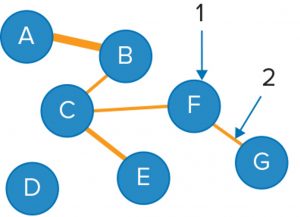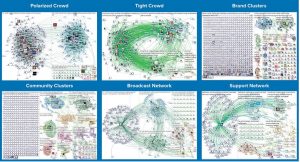
In this module, through data analysis, we will explore patterns while focusing on addressing the following:
- Evaluate data trends to predict and solve marketing problems.
- Evaluate the performance of digital marketing initiatives to achieve Key Performance Indicators (KPI) results for each marketing channel.
Read “Module 4: Readings and Videos Part 2” document before completing the following review activities.
Review Activity #1 Understanding the Basics of Social Network Analysis
Companies use social network analysis to measure entities (e.g., customers, products, services) and the relationships among them. There are several key elements involved in social network analysis. Nodes are an entity (e.g., people, products, stores) and Edges are the links and relationships between nodes.
The goal of this activity is for you to differentiate between nodes and edges.
Use the image to then select the correct answer for the areas labeled 1 and 2.

Review Activity #2 Types of Social Networks
Network structures enable you to visually examine which types of interactions are occurring and how the network is evolving. Different structures emerge in network maps depending upon the network measures. Consider the six structures of networks identified in the image. These network structures were developed based on Twitter topics (Smith et al). While the network structures are not comprehensive, they are examples that are the result of interactions occurring in the network. This activity is important because it will demonstrate your understanding of how network structures vary.
The goal of this activity is for you to understand how network structures can vary.
Based on the chart shown below, select the description that best reflects each network structure.

The following three activities should be completed after “Module 4: Readings and Videos Part 2”.
In-Class-Activity #3 Evaluating Results From Social Network Analysis
Measures of centrality indicate the influence a node has in the network and also a node’s strategic network position. Recall there are different measures of centrality: degree centrality, betweenness centrality, closeness centrality, and eigenvector centrality. The goal of this activity is to demonstrate your understanding of how to evaluate and interpret social network analysis results.
Use the table to answer the questions, then identify the correct definition of the centrality measure.
| Name | Total Degree | Betweenness Centrality | Closeness Centrality | Eigenvector Centrality |
| Emin | 8 | 0.035 | 0.254 | 0.253 |
| Chun | 10 | 0.116 | 0.234 | 0.464 |
| Allen | 8 | 0.126 | 0.190 | 0.426 |
| Kelly | 7 | 0.029 | 0.271 | 0.465 |
| Anita | 6 | 0.000 | 0.360 | 0.000 |
Select the correct centrality measure for each definition
Review Activity #4 Understanding the Basics of Digital Marketing
Digital marketing is the use of marketing touchpoints that are executed electronically through a digital channel to communicate and interact with current and potential customers and partners. These touchpoints can be categorized as different types of media including owned, paid, and earned digital media.
The goal of this activity is to differentiate between owned, paid, and earned digital media.
Categorize each example using the drop-down menu.
Review Activity #5 Digital Marketing Analytics Measures
Companies should determine a comprehensive but manageable set of measurements that align with the overall business strategy. Digital marketing measures that analyze what is happening often fall under four different categories: audience analysis, acquisition analysis, behavior analysis, and conversion analysis.
The goal of this activity is for you to understand questions that might reflect each category.
Match each question to the correct category.

